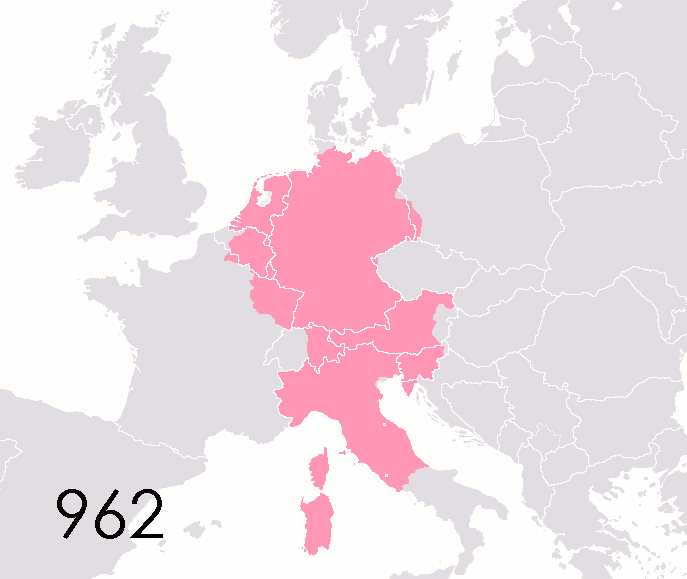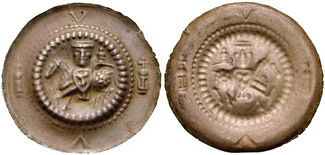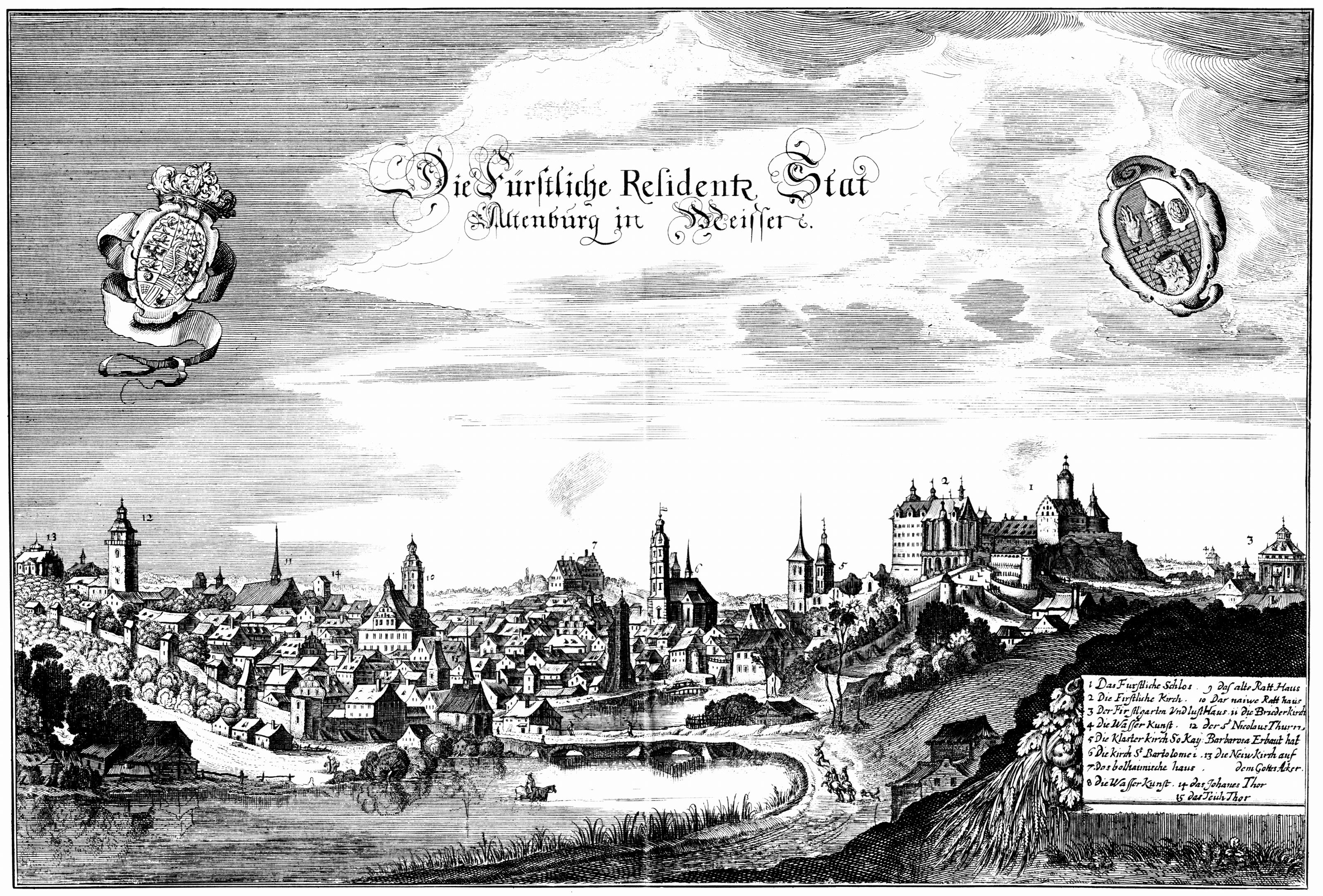|
Duchy Of Saxe-Gotha-Altenburg
Saxe-Gotha-Altenburg () was a duchy ruled by the Ernestine branch of the House of Wettin in today's Thuringia, Germany. The extinction of the line in 1825 led to a major re-organisation of the Thuringian states. History In 1640 the sons of the late Ernestine duke John II of Saxe-Weimar divided their paternal heritage (''Ernestinische Teilung'') whereby Duke Ernest the Pious, a younger son, received the newly established Duchy of Saxe-Gotha. In 1636 Ernest had married Elisabeth Sophie, the only child of Duke John Philip of Saxe-Altenburg. Upon her father's death in 1639, the Duchy of Saxe-Altenburg passed to her uncle Duke Frederick William II and her cousin Frederick William III. The Duchy of Saxe-Gotha-Altenburg was nominally created in 1672, when Duke Frederick William III of Saxe-Altenburg died at the age of 14 and Ernest the Pious, by his marriage with Elisabeth Sophie, inherited the major part of his possessions. It was common for the Ernestine duchies to merge and split ... [...More Info...] [...Related Items...] OR: [Wikipedia] [Google] [Baidu] |
States Of The Holy Roman Empire
This list of states in the Holy Roman Empire includes any territory ruled by an authority that had been granted imperial immediacy, as well as many other feudal entities such as lordships, sous-fiefs and allodial fiefs. The Holy Roman Empire was a complex political entity that existed in central Europe for most of the medieval and early modern periods and was generally ruled by a German-speaking Emperor. The states that composed the Empire, while enjoying a unique form of territorial authority (called '' Landeshoheit'') that granted them many attributes of sovereignty, were never fully sovereign states in the sense that term is understood today. In the 18th century, the Holy Roman Empire consisted of approximately 1,800 such territories, the majority being tiny estates owned by the families of Imperial Knights. This page does not directly contain the list but discusses the format of the various lists and offers some background to understand the complex organisation of the Holy ... [...More Info...] [...Related Items...] OR: [Wikipedia] [Google] [Baidu] |
Gotha (town)
Gotha () is the fifth-largest city in Thuringia, Germany, west of Erfurt and east of Eisenach with a population of 44,000. The city is the capital of the district of Gotha and was also a residence of the Ernestine Wettins from 1640 until the end of monarchy in Germany in 1918. The House of Saxe-Coburg and Gotha originating here spawned many European rulers, including the royal houses of the United Kingdom, Belgium, Portugal (until 1910) and Bulgaria (until 1946). In the Middle Ages, Gotha was a rich trading town on the trade route ''Via Regia'' and between 1650 and 1850, Gotha saw a cultural heyday as a centre of sciences and arts, fostered by the dukes of Saxe-Gotha. The first duke, Ernest the Pious, was famous for his wise rule. In the 18th century, the ''Almanach de Gotha'' was first published in the city. The publisher Justus Perthes and the encyclopedist Joseph Meyer made Gotha a leading centre of German publishing around 1800. In the early 19th century, Gotha was a b ... [...More Info...] [...Related Items...] OR: [Wikipedia] [Google] [Baidu] |
Altenburg
Altenburg () is a city in Thuringia, Germany, located south of Leipzig, west of Dresden and east of Erfurt. It is the capital of the Altenburger Land district and part of a polycentric old-industrial textile and metal production region between Gera, Zwickau and Chemnitz with more than 1 million inhabitants, while the city itself has a population of 33,000. Today, the city and its rural county is part of the Central German Metropolitan Region. Altenburg was first mentioned in 976 and later became one of the first German cities within former Slavic area, east of the Saale river (as part of the medieval Ostsiedlung movement). The emperor Frederick Barbarossa visited Altenburg several times between 1165 and 1188, hence the town is named a Barbarossa town today. Since the 17th century, Altenburg was the residence of different Ernestine duchies, of whom the Saxe-Altenburg persisted until the end of monarchy in Germany in 1918. Industrialization reached Altenburg and the ... [...More Info...] [...Related Items...] OR: [Wikipedia] [Google] [Baidu] |
Friedrich Wilhelm III, Duke Of Saxe-Altenburg
Friedrich Wilhelm III (b. Altenburg, 12 July 1657 – d. Altenburg, 14 April 1672), was a duke of Saxe-Altenburg. He was the second son of Friedrich Wilhelm II, Duke of Saxe-Altenburg and Magdalene Sybille of Saxony, his second wife. Life The death of his older brother Christian (1663) made him the new heir of the Duchy of Saxe-Altenburg. When his father died in 1669, Friedrich Wilhelm III succeeded him; but, because he was only twelve years old, his maternal uncles, Elector Johann Georg II of Saxony and Duke Maurice of Saxe-Zeitz, assumed the guardianship of the new duke and the regency of the duchy. Only three years later, the young duke died of smallpox shortly after returning from a trip to Dresden. His burial took place three months later, on 17 July 1672 at his father's tomb in the church of Schloss Altenburg. With his death, the branch of Saxe-Altenburg, founded in 1603, became extinct in the direct male line. Saxe-Altenburg was split between the branches of Saxe-G ... [...More Info...] [...Related Items...] OR: [Wikipedia] [Google] [Baidu] |
Friedrich Wilhelm II, Duke Of Saxe-Altenburg
Friedrich Wilhelm II (12 February 1603, in Weimar – 22 April 1669, in Altenburg), was a duke of Saxe-Altenburg. He was the youngest son of Friedrich Wilhelm I, Duke of Saxe-Weimar, and Anna Maria of the Palatinate-Neuburg, his second wife. He was born eight months after the death of his father, on 7 July 1602. Shortly after his birth, Friedrich Wilhelm II and his older brothers inherited Saxe-Altenburg as co-rulers under the guardianship of the Electors of Saxony Christian II and John George I until 1618, when his older brother John Philip assumed the government of the duchy and the guardianship of his younger siblings. By 1632, two of his three brothers were deceased. Friedrich Wilhelm II and his older brother John Philip began a joint government; but, in fact, John Philip was the real and only ruler of the duchy of Saxe-Altenburg. Friedrich Wilhelm II was only a nominal ruler until the death of John Philip (1639), when he began his personal reign over Altenburg. At Alt ... [...More Info...] [...Related Items...] OR: [Wikipedia] [Google] [Baidu] |
Johann Philipp, Duke Of Saxe-Altenburg
Johann Philipp (25 January 1597 – 1 April 1639), was a duke of Saxe-Altenburg. He was born in Torgau, the eldest (but fourth in order of birth) surviving son of Friedrich Wilhelm I, Duke of Saxe-Weimar and Anna Maria of the Palatinate-Neuburg, his second wife. Childhood When his father died (1602), Johann Philipp and his younger brothers Frederick, Johann Wilhelm and Friedrich Wilhelm were underage. Because of this, his uncle Johann (more interested in natural sciences and art than politics) took over his guardianship and the regency of his inheritance; but shortly after he took all the duchy of Saxe-Weimar into his own hands. The next year (1603), the young prince of Saxe-Weimar demanded his own inheritance, but his uncle Johann opposed this. But finally, both parts made a divisionary treaty of the family lands: Johann Philipp and his brothers took Altenburg and some towns, and Johann retained Weimar and Jena. Because they were still underage, the regency of his duchy ... [...More Info...] [...Related Items...] OR: [Wikipedia] [Google] [Baidu] |
Elisabeth Sophie Of Saxe-Altenburg
Elisabeth Sophie of Saxe-Altenburg (10 October 1619 – 20 December 1680), was a princess of Saxe-Altenburg and, by marriage, duchess of Saxe-Gotha. She was born in Halle, the only daughter of Johann Philipp, Duke of Saxe-Altenburg, and his wife, Elisabeth of Brunswick-Wolfenbüttel. Life In Altenburg on 24 October 1636, Elisabeth Sophie married her kinsman Ernst I, Duke of Saxe-Gotha. As a dowry, she received 20,000 guilders, who were pledged by the town of Roßla. As Widow's seat, the bride obtained the towns of Kapellendorf and Berka, with the called ''Gartenhaus'' in Weimar. Because according to the succession laws of the House of Saxe-Altenburg (which excluded the women from inheritance), after her father died two years later (1 April 1639), he was succeeded by his brother, Frederick Wilhelm II. When her cousin, the duke Frederick Wilhelm III died childless in 1672, Elisabeth Sophie became in the general heiress of all the branch of Saxe-Altenburg on the basis of ... [...More Info...] [...Related Items...] OR: [Wikipedia] [Google] [Baidu] |
Ernest I, Duke Of Saxe-Gotha
Ernest I, called "Ernest the Pious" (25 December 1601 – 26 March 1675), was a duke of Saxe-Gotha and Saxe-Altenburg. The duchies were later merged into Saxe-Gotha-Altenburg. He was the ninth but sixth surviving son of Johann II, Duke of Saxe-Weimar, and Dorothea Maria of Anhalt. His mother was a granddaughter of Christoph, Duke of Württemberg, and great-granddaughter of Ulrich, Duke of Württemberg. Life Left an orphan early in life (his father died in 1605 and his mother in 1617), he was brought up in a strict manner, and was gifted and precocious but not physically strong. He soon showed traits of the piety of the time. As ruler, by his character and governmental ability as well as by personal attention to matters of state, he introduced a golden age for his subjects after the ravages of the Thirty Years' War. By wise economy, which did not exclude fitting generosity or display on proper occasions, he freed his land from debt, left at his death a considerable sum in ... [...More Info...] [...Related Items...] OR: [Wikipedia] [Google] [Baidu] |
Johann II, Duke Of Saxe-Weimar
Johann II, Duke of Saxe-Weimar (''Johann Maria Wilhelm''; 22 May 1570 – 18 July 1605) was a Duke of Saxe-Weimar and Jena. Biography He was the second son of Johann Wilhelm, Duke of Saxe-Weimar and Dorothea Susanne of Simmern. His father died in 1573, when Johann was only three years old. Since at the time his older brother Frederick William I was also under age, the duchy of Saxe-Weimar (originally awarded to Johann) was governed by a regency. In 1586 his older brother reached adulthood and took full control of the duchy, including Weimar. However, he died in 1602 and the full duchy was inherited by Johann, because his nephews (the sons of his deceased brother) were under age. Johann was more interested in natural sciences and art than politics, and therefore only against his will took over the regency of the duchy on behalf of his nephews. But when they demanded their own inheritance in 1603, he resisted their demands. Finally, Johann and his nephews made a treaty divid ... [...More Info...] [...Related Items...] OR: [Wikipedia] [Google] [Baidu] |
Thuringian States
The Thuringian states (german: Thüringische Staaten) refers to the following German federal states within the German Reich: *The Grand Duchy of Saxe-Weimar-Eisenach, officially the Grand Duchy of Saxony (''Großherzogtum Sachsen'') from 1903 *The duchies of Saxe-Altenburg, Saxe-Coburg and Gotha and Saxe-Meiningen (''Herzogtum Sachsen-Altenburg, Herzogtum Sachsen-Coburg und Gotha, Herzogtum Sachsen-Meiningen'') *The principalities of Reuss Elder Line (''Fürstentum Reuß Ältere Linie''), Reuss Younger Line (''Fürstentum Reuß Jüngere Linie''), Schwarzburg-Rudolstadt (''Fürstentum Schwarzburg-Rudolstadt'') and Schwarzburg-Sondershausen (''Fürstentum Schwarzburg-Sondershausen'') Territory These lands were bordered to the north and west by Prussian regions, especially the ''Regierungsbezirk'' of Erfurt, but also those of Kassel and Merseburg, in places as enclaves. In addition numerous Prussian exclaves were mixed up among the Thuringian states. These were the county (''Landk ... [...More Info...] [...Related Items...] OR: [Wikipedia] [Google] [Baidu] |
Germany
Germany, officially the Federal Republic of Germany (FRG),, is a country in Central Europe. It is the most populous member state of the European Union. Germany lies between the Baltic and North Sea to the north and the Alps to the south. Its 16 constituent states have a total population of over 84 million in an area of . It borders Denmark to the north, Poland and Czechia to the east, Austria and Switzerland to the south, and France, Luxembourg, Belgium, and the Netherlands to the west. The nation's capital and most populous city is Berlin and its main financial centre is Frankfurt; the largest urban area is the Ruhr. Settlement in what is now Germany began in the Lower Paleolithic, with various tribes inhabiting it from the Neolithic onward, chiefly the Celts. Various Germanic tribes have inhabited the northern parts of modern Germany since classical antiquity. A region named Germania was documented before AD 100. In 962, the Kingdom of Germany formed the ... [...More Info...] [...Related Items...] OR: [Wikipedia] [Google] [Baidu] |


